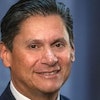As the world of higher education awaits a U.S. Supreme Court decision expected to strike down race-conscious admissions policies, a new report from the Center on Education and the Workforce at Georgetown University is offering more evidence of what a post-affirmative action landscape might look like. Its findings are unambiguous: selective colleges and universities are likely to become less ethnically and racially diverse. And although certain admissions models using socioeconomic status (SES) allowed colleges to match or even slightly exceed current levels of diversity, they require systemic changes to admissions practices that are not considered realistic.
 Dr. Anthony P. Carnevale, CEW director and lead author of the report.
Dr. Anthony P. Carnevale, CEW director and lead author of the report.
Carnevale and his co-authors simulated six possible admissions models for the 290,000 slots at nearly 200 selective schools. In two models, they expanded the consideration of race and ethnicity nationwide, and in four, they eliminated it entirely. Several of the models used SES as a factor, in combination with high school class rank and academic merit (based on factors like grades and standardized test scores). The researchers also varied applicant pools, in some models trying to realistically represent who would apply, and in some models, using the entire graduating high school class. No models considered legacy admissions, athlete preferences, and other advantages that typically favor richer, white applicants, because data was not available.
The simulations showed that the models that expanded race-conscious admissions rather than banning it came close to matching the increasingly diverse racial and ethnic composition of the graduating high school class. African American, Hispanic, and American Indian, Alaska Native, Native Hawaiian, and Pacific Islander students were under-represented in all models that ignored race and ethnicity.
The researchers did find that class-conscious admissions policies—those in which SES is considered—could help compensate for a ban on affirmative action by allowing schools to “claw back” some measure of diversity, or even to exceed their current levels. In one model, which considered academic merit and SES, the proportion of Hispanics went up 0.5 percentage points from fall 2020 levels to 14.6%, and the share of African Americans increased 0.4 points, to 6.3%. However, this scenario involved every single selective college using SES in its admissions, and did not include legacy admissions, athlete preferences, and the like—a highly unrealistic scenario.
That model also resulted in less representation for American Indian, Alaska Native, Native Hawaiian, and Pacific Islander students: their percentage dropped from 0.3% to 0.2%. This echoed the results of nearly every other model, which Dr. Zachary Bleemer, an assistant professor of economics at the Yale School of Management, attributed to sharp disparities in educational access. The only model in which the proportions of all under-represented groups increased was one in which colleges directly admitted students from the entire high school graduating class, not just those who applied to them specifically, an upending of the admissions system that seems nearly impossible.
“In the realistic world where the Supreme Court bans the use of race in admissions and selective colleges are maintaining preferences for legacies and other privileged groups, we’re not going to see the types of race and class diversity that we show is possible,” said Dr. Zachary Mabel, research professor of education and economics at CEW and a co-author of the report. “If you’re fundamentally changing the way that college admissions works, you can claw back or even exceed the representation for some under-represented groups, but in a world where you’re getting rid of race but preserving the status quo for all else, you’re just going to see a lot of declines in racial diversity on campus.”
 Dr. Zachary Bleemer, an assistant professor of economics at the Yale School of Management
Dr. Zachary Bleemer, an assistant professor of economics at the Yale School of Management
Even efforts to recruit more diverse applicant pools could be in danger soon, according to Dr. Stella M. Flores, an associate professor of higher education at the University of Texas at Austin.
“Anything that has a purpose to diversify or add equity or include underserved groups is in question right now,” she said, citing a wave of anti-diversity sentiment and bills restricting DEI efforts in 17 states, including Florida and Texas. “They’re removing any form of outreach that could get to communities of color to even think about going to certain types of colleges.”
Overall, said Bleemer, the near future for campus diversity is gloomy, even for institutions that try to implement alternatives to race-conscious affirmative action.
“Public universities have been experimenting for 20 years and have hardly moved the needle at all,” he said, referring to efforts in states where affirmative action has been banned.
Carnevale was more emphatic.
“It’s going to curb our ability to have racial diversity in elite institutions, period,” he said.
Jon Edelman can be reached at [email protected]


















